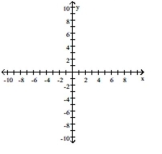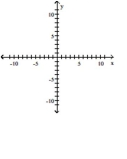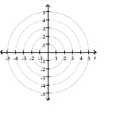A) hyperbola
B) ellipse
C) parabola
D) not a conic
Correct Answer

verified
Correct Answer
verified
Multiple Choice
Discuss the equation and graph it. -
A) directrix perpendicular to polar axis 8 right of pole
center
vertices ![]()
B) directrix parallel to polar axis 8 above pole center vertices ![]()
C) directrix perpendicular to polar axis 8 left of pole
center
vertices ![]()
D) directrix parallel to polar axis 8 below pole center vertices ![]()
Correct Answer

verified
Correct Answer
verified
Multiple Choice
Rotate the axes so that the new equation contains no xy-term. Discuss the new equati -
A)
ellipse
center at
major axis is -axis
vertices at
B)
ellipse
center at
major axis is -axis
vertices at and
C)
parabola
vertex at
focus at
D)
hyperbola
center at
transverse axis is the -axis
vertices at )
Correct Answer

verified
Correct Answer
verified
Multiple Choice
Write an equation for the hyperbola.
-
A)
B)
C)
D)
Correct Answer

verified
Correct Answer
verified
Multiple Choice
Match the graph to its equation.
-
A)
B)
C)
D)
Correct Answer

verified
Correct Answer
verified
Multiple Choice
Find the center, transverse axis, vertices, foci, and asymptotes of the hyperbola. -
A) center at
transverse axis is -axis
vertices:
foci:
asymptotes of and
B) center at
transverse axis is -axis
vertices:
foci:
asymptotes of and
C) center at
transverse axis is -axis
vertices:
foci:
asymptotes of and
D) center at
transverse axis is y-axis
vertices at and
foci at and
asymptotes of and
Correct Answer

verified
Correct Answer
verified
Multiple Choice
Find an equation for the parabola described.
-Vertex at (6, 1) ; focus at (6, 3) A)
B)
C)
D)
Correct Answer

verified
Correct Answer
verified
Multiple Choice
Rotate the axes so that the new equation contains no xy-term. Graph the new equation.
-

A) ![]()
B) ![]()
Correct Answer

verified
Correct Answer
verified
Multiple Choice
Find the vertex, focus, and directrix of the parabola. Graph the equation.
- ![]()
A) vertex:
focus:
directrix: ![]()
B) vertex:
focus:
directrix: ![]()
C) vertex:
focus:
directrix: ![]()
D) vertex:
focus:
directrix: ![]()
Correct Answer

verified
Correct Answer
verified
Multiple Choice
Name the conic.
-
A) circle
B) parabola
C) hyperbola
D) ellipse
Correct Answer

verified
Correct Answer
verified
Multiple Choice
Identify the equation without applying a rotation of axes. -
A) parabola
B) hyperbola
C) ellipse
D) not a conic
Correct Answer

verified
Correct Answer
verified
Multiple Choice
Graph the curve whose parametric equations are given.
- ![]()
A) ![]()
B) ![]()
C) ![]()
D) ![]()
Correct Answer

verified
Correct Answer
verified
Multiple Choice
Find an equation for the hyperbola described. Graph the equation.
-Center at focus at ;vertex at

A) ![]()
B) ![]()
C) ![]()
D) ![]()
Correct Answer

verified
Correct Answer
verified
Multiple Choice
Solve the problem. -An experimental model for a suspension bridge is built in the shape of a parabolic arch. In one section, cable runs from the top of one tower down to the roadway, just touching it there, and up again to the top of a second Tower. The towers are both 12.25 inches tall and stand 70 inches apart. Find the vertical distance from the Roadway to the cable at a point on the road 14 inches from the lowest point of the cable.
A) 2.16 in.
B) 1.76 in.
C) 7.84 in.
D) 1.96 in.
Correct Answer

verified
Correct Answer
verified
Multiple Choice
Identify the equation without completing the square. -
A) ellipse
B) hyperbola
C) parabola
D) not a conic
Correct Answer

verified
Correct Answer
verified
Multiple Choice
Find an equation for the ellipse described. -Center at focus at ; vertex at
A)
B)
C)
D)
Correct Answer

verified
Correct Answer
verified
Multiple Choice
Determine the appropriate rotation formulas to use so that the new equation contains no xy-term. -
A) and
B) and
C) and
D) and
Correct Answer

verified
Correct Answer
verified
Multiple Choice
Discuss the equation and graph it.
-

A) ellipse, directrix parallel to the polar axis unit below the pole vertices ![]()
B) ellipse, directrix perpendicular to the polar axis unit left of the pole vertices ![]()
C) hyperbola; directrix parallel to the polar axis unit above the pole vertices ![]()
D) hyperbola, directrix perpendicular to the polar axis unit right of the pole vertices ![]()
Correct Answer

verified
Correct Answer
verified
Multiple Choice
Match the equation to the graph. -
A) ![]()
B) ![]()
C) ![]()
D) ![]()
Correct Answer

verified
Correct Answer
verified
Multiple Choice
Solve the problem. -An experimental model for a suspension bridge is built in the shape of a parabolic arch. In one section, cable runs from the top of one tower down to the roadway, just touching it there, and up again to the top of a second Tower. The towers stand 50 inches apart. At a point between the towers and 15 inches along the road from the Base of one tower, the cable is 1 inches above the roadway. Find the height of the towers.
A) 6.75 in.
B) 5.75 in.
C) 6.25 in.
D) 8.25 in.
Correct Answer

verified
Correct Answer
verified
Showing 41 - 60 of 197
Related Exams